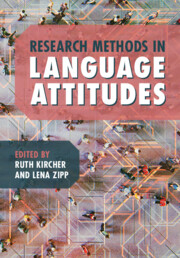Book contents
- Research Methods in Language Attitudes
- Research Methods in Language Attitudes
- Copyright page
- Contents
- Figures
- Tables
- Contributors
- Foreword
- Acknowledgements
- 1 An Introduction to Language Attitudes Research
- Part 1 Analysis of the Societal Treatment of Language
- Part 2 Direct Methods of Attitude Elicitation
- Part 3 Indirect Methods of Attitude Elicitation
- Part 4 Overarching Issues in Language Attitudes Research
- 17 Researching Language Attitudes in Multilingual Communities
- 18 Researching Language Attitudes in Signing Communities
- 19 Researching Language Attitudes Based on Historical Data
- 20 The Use of Priming in Language Attitudes Research
- 21 Mixed-Methods Approaches to the Study of Language Attitudes
- References
- Index
- References
19 - Researching Language Attitudes Based on Historical Data
from Part 4 - Overarching Issues in Language Attitudes Research
Published online by Cambridge University Press: 25 June 2022
- Research Methods in Language Attitudes
- Research Methods in Language Attitudes
- Copyright page
- Contents
- Figures
- Tables
- Contributors
- Foreword
- Acknowledgements
- 1 An Introduction to Language Attitudes Research
- Part 1 Analysis of the Societal Treatment of Language
- Part 2 Direct Methods of Attitude Elicitation
- Part 3 Indirect Methods of Attitude Elicitation
- Part 4 Overarching Issues in Language Attitudes Research
- 17 Researching Language Attitudes in Multilingual Communities
- 18 Researching Language Attitudes in Signing Communities
- 19 Researching Language Attitudes Based on Historical Data
- 20 The Use of Priming in Language Attitudes Research
- 21 Mixed-Methods Approaches to the Study of Language Attitudes
- References
- Index
- References
Summary
This chapter outlines how historical data can be used for research on language attitudes, concentrating on the field of historical sociolinguistics. It first discusses methodological challenges when working with historical data. Since historical (socio-)linguists cannot elicit data, they rely on the written and typically fragmented data available, which provide limited access to the attitudes of individuals. Furthermore, the boundaries between language attitudes and language ideologies are less sharply drawn in historical sociolinguistic research than in research on present-day data. Attitudes and ideologies are usually not addressed separately and often set in other linguistic contexts, such as language standardisation, linguistic purism, and prescriptivism. The second section of the chapter provides an overview of promising text sources that can be utilised to study language attitudes in the past, including normative texts, ego-documents, and statistical accounts, discussing both their potentials and drawbacks. The third section explains how these sources can be analysed, focussing on discourse-analytical and corpus-linguistic methods. To illustrate the main points made in this chapter, two case studies (one on German and one on Dutch) are presented. The chapter concludes with a brief discussion of emerging trends in historical sociolinguistics, particularly the move towards studying language attitudes in multilingual settings.
Keywords
- Type
- Chapter
- Information
- Research Methods in Language Attitudes , pp. 297 - 312Publisher: Cambridge University PressPrint publication year: 2022

